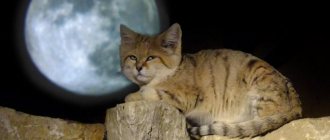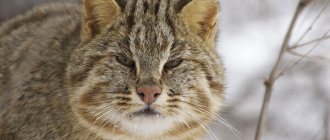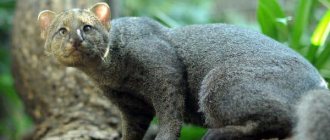Origin story
In the first epoch of the Cenozoic era, 60 million years ago, a family of terrestrial carnivorous predators formed on earth. From the family of mammals from the order of predators came the genus of felines Pseudoailurus, from which the subfamilies of cats originate: small, large and saber-toothed cats.
The forest cat comes from the subfamily of small cats. Ancient small predators lived in North America, Asia and Europe. Animals have taken root well on the American continent; the most exotic representative of felines is the American forest cat, the ocelot.
Forest cats are predators, the history of whose origin stretches back to centuries ago. In a variable climate, from periods of drought to abnormally low temperatures, wild cats have survived.
Having survived natural disasters, wild forest cats began to adapt to life in harsh, impassable places. Small forest predators have taken root well in forests, hence the name forest cat.
Felis silvestris is the Latin name for the subspecies, meaning wild cat. The forest wild cat is listed in the Red Book. Purebred extinction of wild forest cats occurs due to mating with homeless outbred felines.
More expensive than all the shows
Before finding out how much a Russian Blue cat costs, the future owner must decide why he is getting one. The class depends on the purpose, and the price depends on the class.
The breeder will ask at least 5 thousand rubles for a pet-class kitten with a veterinary passport and the necessary vaccinations. You won’t go to an exhibition with this, but the breed will be visible.
If you also need a pedigree in order to start breeding yourself, you should pay attention to the breeding class and prepare at least 17 thousand rubles. Show-class babies will be the most expensive; 25 thousand rubles is the minimum. In general, they can ask for 35.
Appearance of wild forest cats
In appearance, a wild forest cat is very similar to domestic pets, but it is much larger than them. The body is denser, the coat is short and thick. This coat color promotes camouflage in the wild. Dense, tall and thick fur protects from the cold.
The weight of males can reach 8–10 kilograms, females are slightly smaller and weigh about 5 kilograms. The length of the body without a tail is from 40 to 90 cm, the tail is fluffy with a tassel, the length of which reaches 25–30 cm. Sharp small teeth and large powerful claws help to survive in the harsh realities of the wild.
Wild forest animals have sensitive vision and keen hearing. These are beautiful and graceful cats with powerful hind legs that can move quickly. Wild forest cats are not as friendly as their domesticated relatives.
There are different types of forest cats:
- The Scottish forest cat lives in northern Scotland in juniper thickets and small plantings. Hunts at night for rabbits, mice, birds and small rodents. A nature reserve has been created on the west coast of Scotland to save an endangered species. Today there are approximately 35 purebred Scottish forest cats.
- The Caucasian forest predator lives in the mountains of the northern Caucasus. This is a very rare species that is on the verge of extinction.
- The Far Eastern leopard cat lives in Primorye, less often in China. The local name Amur forest cat comes from the Bengal cat with a characteristic brown coat color and red spots. It hunts at night and lives in the densest impenetrable thickets.
- In the south of Russia, a forest cat lives in the reed thickets in the Astrakhan region. The reed forest cat breed is very similar to the swamp lynx.
- The wild forest cat of America, the ocelot, lives in South America. The low population of the American forest cat could lead to its complete extinction. This species is listed in the Red Book.
- The European wild cat is large, has a thick coat, light color from light gray to brown, with dark transverse rings on the sides, and stripes on the tail. Habitat: Europe, Western Ukraine, territory of Belarus, North Caucasus. They settle in forests, climb mountains, hunt not only small rodents, but also hares, rabbits, and young roe deer.
- The African golden cat, despite its beautiful color, has a very capricious and evil character. Reaches a weight of 14 kilograms, hunts every day small antelopes, gazelles and birds, and does not disdain small monkeys.
What else you need to know about the Norwegian forest cat
The decision to have a pet should be balanced, so you should take into account all the features of Norwegian forest cats. Skogcats have a number of advantages, which include:
- calm character;
- high level of intelligence;
- unobtrusiveness;
- good manners;
- beautiful appearance;
- excellent hunting skills;
- good health.
Representatives of this breed mature quite late (closer to 5 years of age). Therefore, they are not inclined to constantly search for a partner, which helps the owners avoid many problems.
However, skogcats also have their disadvantages:
- allergenicity;
- frequent shedding;
- exactingness in caring for the coat;
- the need for compulsory walking.
Norwegian cats maintain a playful temperament throughout their lives. They require a lot of free space, a variety of toys, as well as special play complexes, which are not always possible to place in a small living space.
If the decision to purchase has been made, then future owners should know some of the nuances of maintenance, care and breeding. It is also important to choose the right healthy kitten, focusing on the recommendations of specialists.
Tips for choosing a kitten
Finding a real skogcat in Russia is not so easy. Only a few nurseries are engaged in breeding this breed, which are located in large cities: Moscow and St. Petersburg. The cost of a kitten can reach 50 thousand rubles and more. But there are also less expensive options. Kittens that are not suitable for breeding will be cheaper. Exhibition animals with rare colors, on the contrary, will cost much more.
In order not to acquire a non-pedigreed or sick one, experts give the following recommendations:
- purchase an animal only from a specialized nursery;
- carefully check the accompanying documentation, including veterinary passport certificate, pedigree, purchase and sale agreement;
- inspect the animal’s coat to ensure it corresponds to breed standards in color and length;
- To assess the socialization and appearance of a kitten, the following signs should alert you: excess weight or exhaustion, dirty ears, cloudy eyes, a swollen belly, the presence of parasites, bald spots, dull fur.
It is important to consider the conditions in which the animals are kept, what they are fed, whether the parents are healthy, etc. You can adopt a kitten at 3 months of age. By this time, the baby will have time to learn all the necessary skills from his mother and will become more independent.
Character and habits
The forest cat is very timid, distrustful and unfriendly. Leads a hermit's lifestyle. They hunt small forest rodents, birds, hares, and rabbits. The predator can stalk its prey for hours and, thanks to its lightning-fast movements, powerful claws and sharp fangs, can grab its prey in a jump. Sometimes they wait for prey near the hole.
Forest cats have adapted to live in the wild in difficult conditions in remote, inaccessible places. They prefer to live alone, marking their territory with an area of about 2–3 kilometers. There is a struggle for the development of the territory with other representatives of wildlife.
Description
The appearance of Siberians is very characteristic, it is difficult to confuse them with other breeds, except perhaps with the wild Maine Coon (pictured):
- medium-sized body, powerful skeleton;
- massive neck;
- large or medium muzzle;
- tassels in ears slightly tilted to one side;
- huge, round eyes that can be yellow or green;
- massive limbs;
- dense, medium-length fur, which has the unique property of repelling water (the purr can survive even severe frosts, and all thanks to the double layer of undercoat);
- a chic tail with thick hair flowing down.
Breeders indicate in the breed standard a weight of up to 6 kg, but in reality pets sometimes reach 12 kg, and do not suffer from obesity. Coat colors are Abyssinian, point, lilac and Brumes.
Lifestyle and nutrition
Forest cats have adapted to life in the wild and obtain food by hunting during the twilight period or at night. Excellent hearing and vision help in hunting. Prey includes hares, rabbits, birds, small rodents, muskrats and fish. Birds that nest on the ground are a favorite treat for cats. Great luck if you come across weakened deer and roe deer cubs.
A forest cat can eat up to 1 kilogram of food at a time. Predators drink little; they can even quench their thirst with sea water. In winter they hunt daily, feeding on small animals and birds. During the day, cats lie down in their den.
The home is an abandoned hole, a hollow, a crevice in the mountains. During the harsh seasons, the European wild forest cat, due to the thick snow cover, settles closer to human habitation. Here they become unwanted guests in poultry houses. Along with damage to the households of rural residents, they bring great help in the fight against harmful rodents.
Keeping a pet
What the Siberian cat loves is walks in the fresh air - even frost does not stop the “fluffy” one. Locking her in a warm apartment will not work - the Siberian will definitely find a way to break free, admire the beauty of nature and hunt, so give her this opportunity.
If your cat is litter box trained and can go outside freely, she will most likely choose to go to the toilet outside the house. The fluffy purr prefers meat, fish, eggs, and greens in food. To maintain health, you need to regularly mix herbal supplements and vitamins into natural dishes, which will be the best for your furry, the veterinarian will tell you. It is difficult to transfer a cat to artificial feeding, because she is a real natural, forest dweller.
A corner equipped for the mustachioed dog will help organize an active lifestyle; it is advisable to buy a sleeping place as well. Despite good immunity, veterinarians advise not to forget about vaccinations, which will make the Siberian a truly perfect representative of the forest breed.
Features and habitat of the forest cat
Forest cats are widespread in Northern Asia and Africa, Europe, the British Isles and Latin America. Currently, all continents of the Earth are inhabited by wild forest cats, only Antarctica is not subject to the presence of predators.
Cats have adapted well to different natural climatic conditions and live in different places. The forest cat in Belarus looks like a domestic pet, but is much larger. It lives in the forest, but in winter it can be found near human habitation.
The forest cat of Latin America prefers to live in dense forests. In Russia, the forest cat lives in a limited area and is protected in nature reserves.
Life in captivity
The European forest cat endures captivity with difficulty. This is due to the fact that the animal needs space and freedom of action.
Cramped apartments are definitely not suitable for such cats, because in nature they run 3–4 km every day. It is also impossible to keep animals near people because of their poor adaptability to humans. A cat will never become affectionate and docile; a person will always remain an enemy for him (at best, he will constantly hide from people, but may show signs of aggression).
The necessary conditions
There are cases when a European forest cat has to be kept in captivity (for example, a weakened and wounded animal that is unable to survive in the forest). Then it is very important to create the right conditions.
You will definitely have to set up an outdoor enclosure. It must be large (for one individual - at least 15 meters in length and width and at least 3 meters in height). There must be a roof on top (otherwise the cat will run away, because he climbs and jumps well). Inside there should be different shelters where the animal can hide, and a variety of branches and ladders for climbing.
A cat in captivity will have to be fed its usual food - rodents or raw poultry (chicken, turkey, duck are suitable). An adult cat requires 0.9–1 kg of meat per day. The cat gets vitamins from the grass and grains it eats (sprouted oats are suitable).
Despite the fact that a wild cat is almost the same size as a domestic cat, it requires 3 times more meat
It is important to remember that a forest cat will always remain a wild animal, even if it has lived next to people for several years. Don't try to communicate with him like a pet. Attempts to pet, hug, or force this animal to do something will provoke aggression (and the claws and fangs of wild cats are very sharp).
Life expectancy and health
On average, a forest cat lives about 10 years. However, some animals die at a young age. A small proportion of individuals reach old age; old age in an animal occurs at 12–15 years.
In the wild, the furry forest animal has many enemies. Among them, the most dangerous are wolves, lynxes, jackals, and less commonly, foxes and martens. Thanks to their physiology, the ability to move quickly, swim and jump far, they manage to avoid encounters with enemies.
Wild cats have an excellent immune system and do not have genetic diseases. With good care in captivity they can live more than 25 years.
Reproduction
Females reach sexual maturity in the first year of life, and males only after 3 years. The mating season for wild cats begins in the spring and continues until summer. Fierce battles between rivals are accompanied by fights and menacing sounds. The winner mates with the female.
The female's pregnancy lasts 2 months, during which time she prepares her rookery for future offspring. In abandoned burrows, in hollow trees or in the empty trunk, she lines her lair with grass and feathers.
There can be a different number of kittens in a litter, usually from 3 to 7. Upon birth, the cubs develop quickly, after 5–7 days the eyes open and after a month the forest kitten is already crawling out of the shelter. Up to 4 months, the female feeds the kittens with her milk. At the age of 6 months, wild cat kittens leave the care of their mother and begin an independent lifestyle.
Don Sphynx
The first kitten of the Don Sphynx with a bald back was taken from children on the street by a resident of Rostov-on-Don; the first offspring of the cat Varvara was also hairless, which gave rise to the development of a new breed. As a result of further breeding, another line of Sphynxes appeared, unrelated to the Canadian ones.
Representatives of this breed at first glance are very similar to their foreign counterparts, but a professional breeder or an experienced fancier will immediately notice the differences due to a different set of genes.
Kittens can be born completely bald, covered with short down or dense thick hair. The body structure is also lighter compared to Canadians, this breed is distinguished by a different eye shape and other little details, this is a real Russian breed that has earned worldwide recognition.
A kitten can be purchased for 9-30 thousand rubles.
Forest cat at home
Catching a wildcat is very difficult. There are certain features of maintenance and care at home. The character of a wild cat bears little resemblance to its domestic relative, although outwardly they differ only in size.
Taming a forest cat is almost impossible. Even the offspring of a domestic cat and a forest predator are very difficult to raise. Wild habits and uncontrollable temperament are transmitted at the genetic level.
The diet of the European wild forest cat should be as close to natural as possible. It is strictly not recommended to take a forest predator into your home if there are already pets there.
Coexistence is almost impossible; predatory habits, freedom-loving disposition and independence make keeping a forest cat at home a difficult task.
Interesting Facts
In the Middle Ages in Spain, the fur of the Pyrenean wild cat was used to make trim for cloaks and dresses of high society. They also made parchment on which, for example, the laws of the Iberian Peninsula were written.
In our time, wild cats still live on the Iberian (Pyrenees) Peninsula. The size of these animals has not changed since the Ancient Quaternary era. The common European wild cat lives in the north of the peninsula, and the giant Iberian cat lives to the south. The last species is one of the largest.











